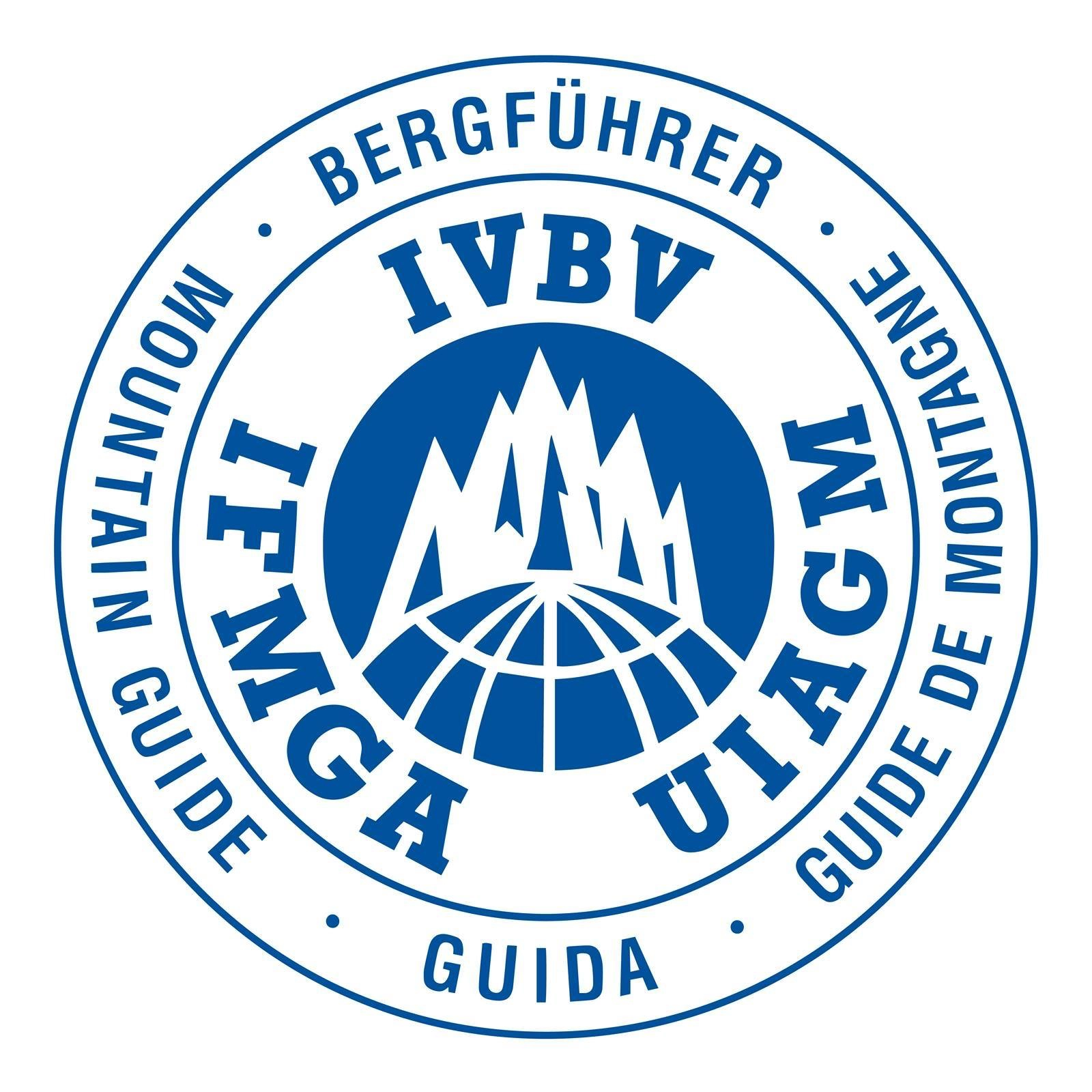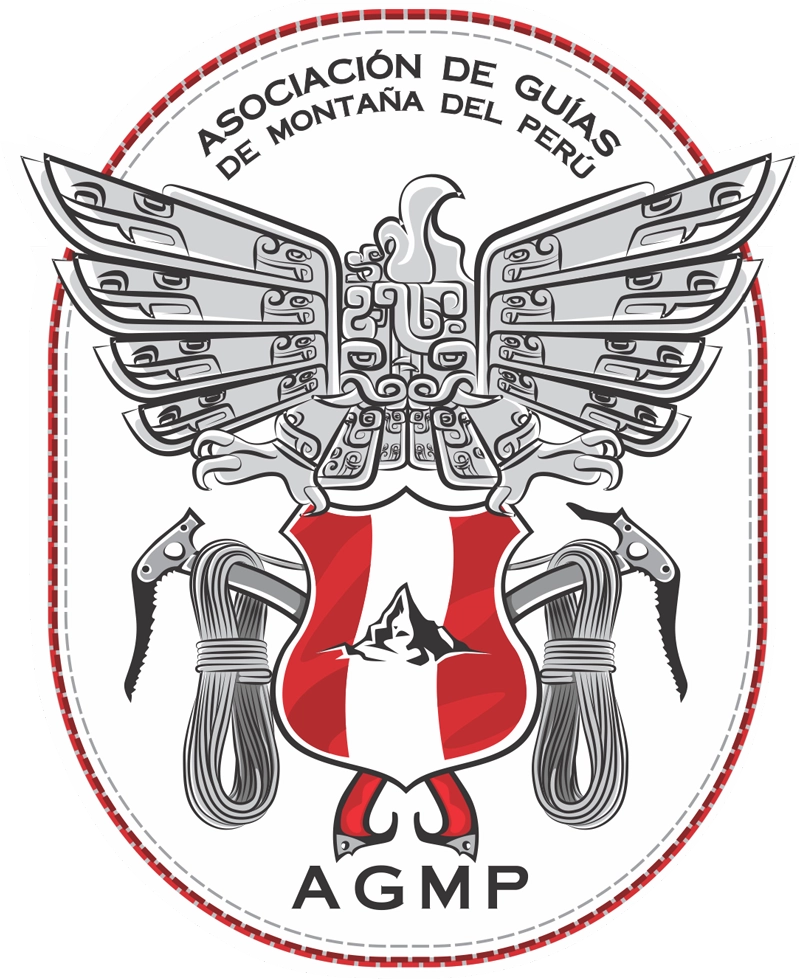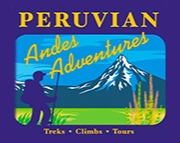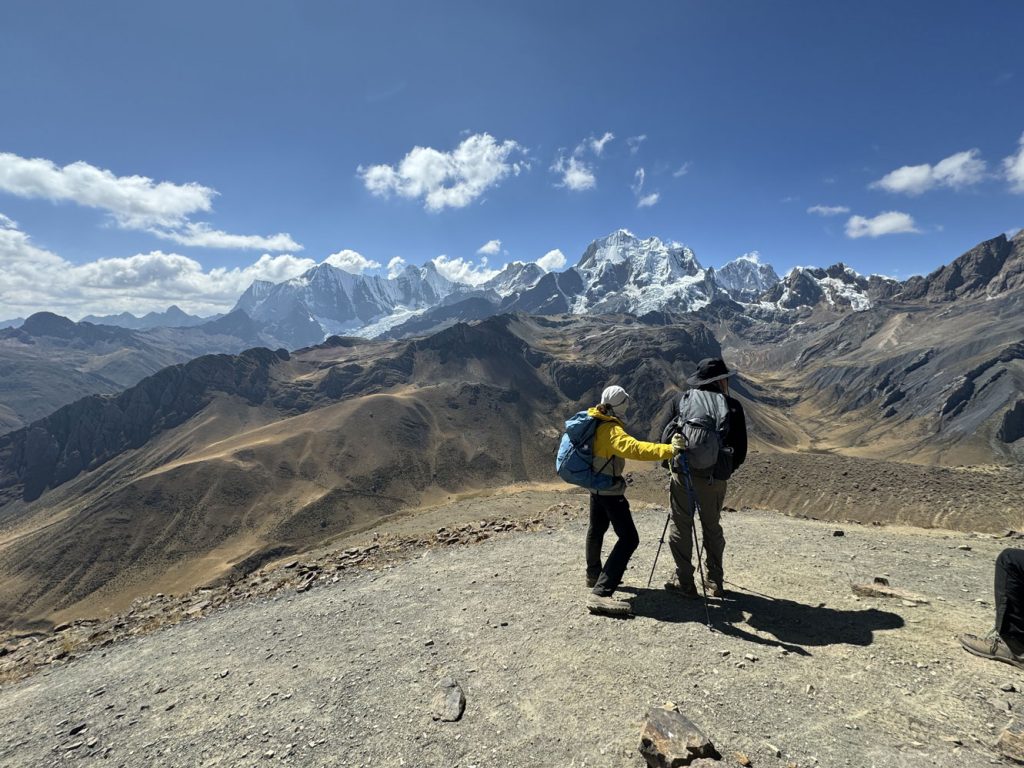
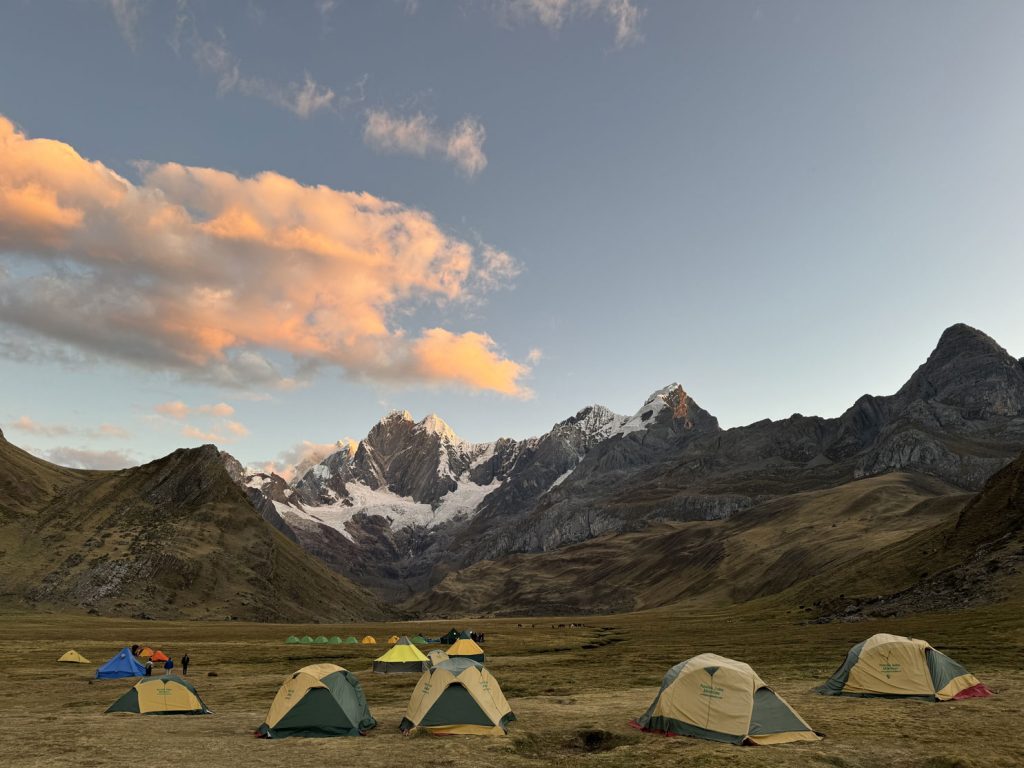
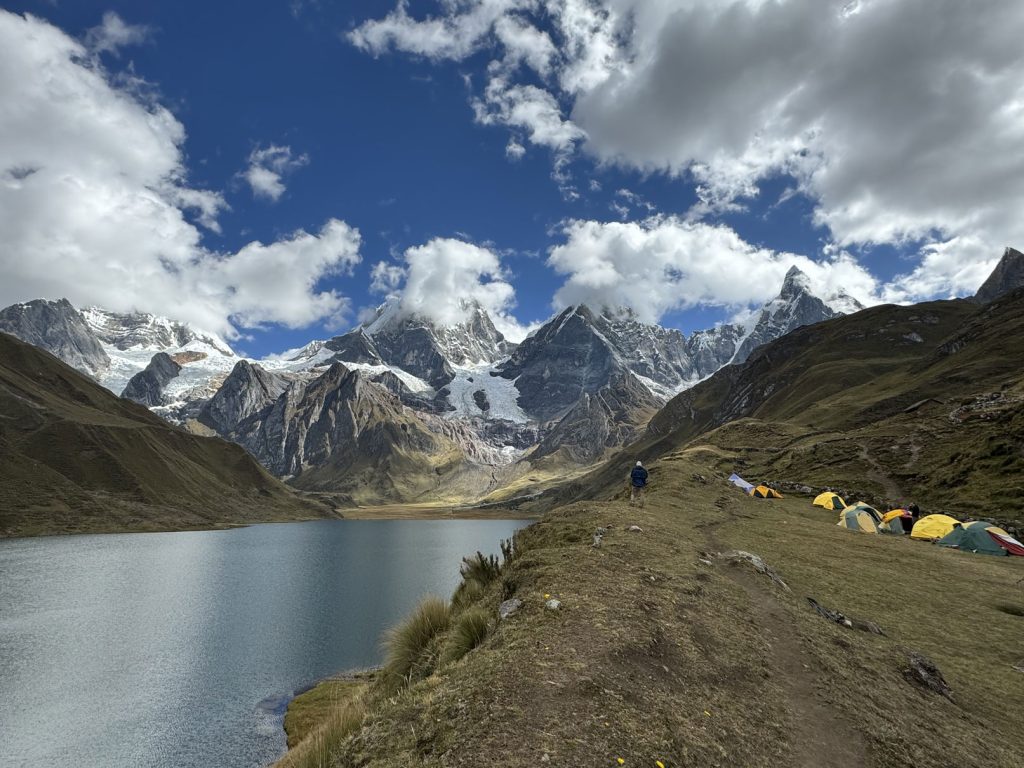
15 day circuit - Siula Base Caamp Trek
15 days trekking
Grade:
Hard
Highest Point:
Cuyoc Pass at 5017m / 16460ft
The Cordillera Huayhuash Circuit has been nominated in several guidebooks as one of the classic trekking circuits of the world.
The Huayhuash is a compact, rugged range of jagged, vertical summits, including the second highest peak in Peru, Yerupajá Grande (6634m), as well as half a dozen other peaks above six thousand metres.
Every day on this trek, hikers are treated to awesome views of towering snow capped peaks, glaciers and turquoise-blue trout-filled lakes. There are 9 passes to cross on this spectacular trek, the highest (Cuyoc) at 5017m.
Our 15 day trek features a visit to the Base Camp of Siula Grande, made famous by the epic Joe Simpson book and film “Touching the Void”
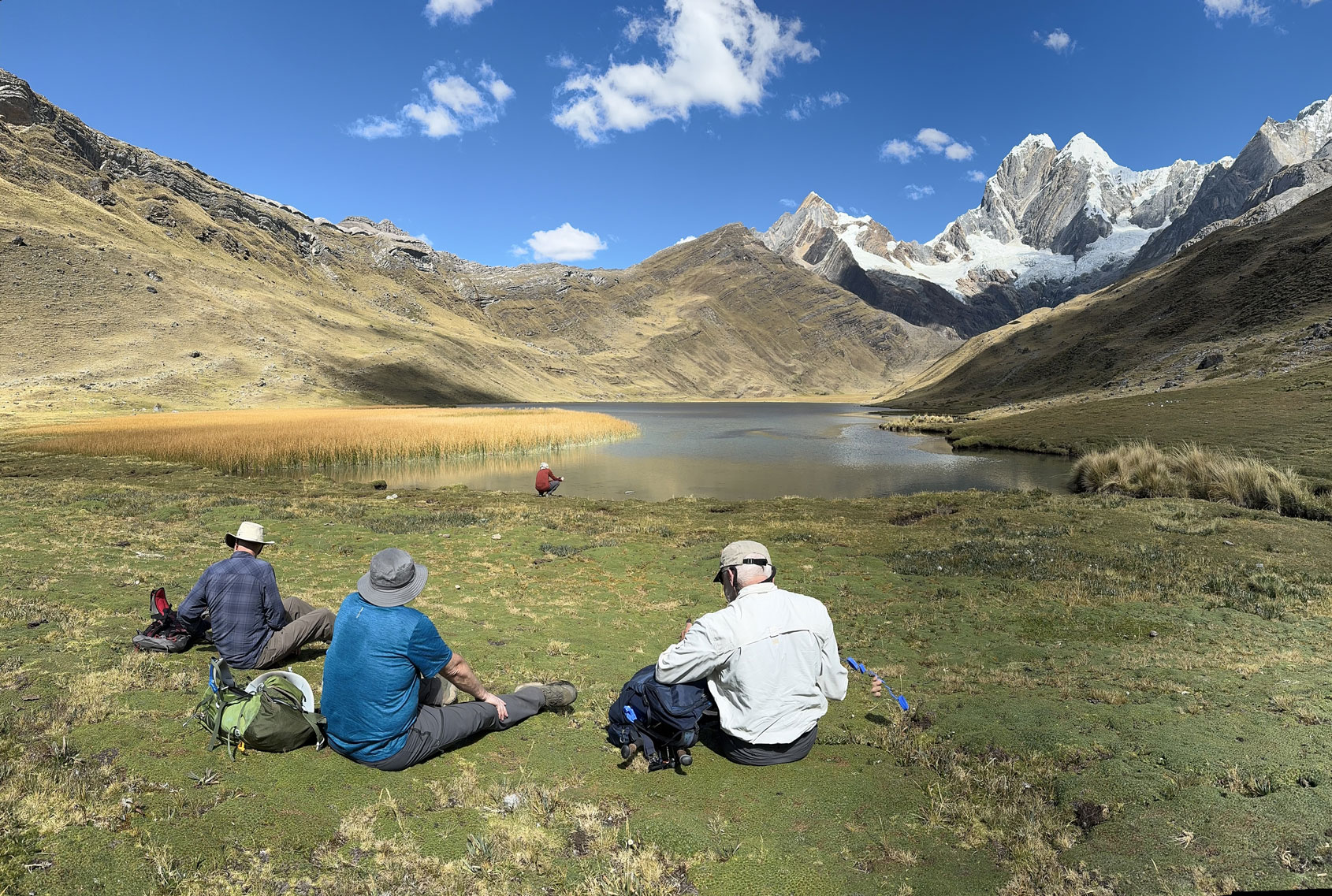
Note 1: Grading
There are some demanding days of hiking on this trek and the length of the trek and the number of high passes together with two weeks of being continuously at altitudes above 4000m / 13123ft warrants a grade of Hard. You do need to have a good level of fitness and be comfortable with hiking a sustained uphill climb of two to three hours, and be able to manage prolonged descents from passes, with some short sections on loose & uneven ground. Trails are not formed paths and are not maintained, they are dirt trails also used by animals and are uneven underfoot.
After crossing the Cerro San Antonio range via Santa Rosa / Jurau Pass towards Siula Grande Base Camp there is a section of around 200m immediately below the pass where you descend down a steep shingle scree slope and you need to be comfortable with this type of alpine descent.
Most trekking options in the Cordillera Huayhuash & Blanca should be considered to be physically demanding owing to the altitude (you are above 4000m for the duration of the treks) and the mountainous nature of the terrain. Trails on this trek are often steep – both ascending or descending and can be slippery & rocky in places. If you do not think you can enjoy this type of trekking, let us know and we can suggest some easier options
Note 2
Walking times are average hiking times. The altitude affects people differently. Some people will be faster than the indicated times and others will be much slower
Note 3
The Cordillera Huayhuash is becoming known to be one of the most beautiful high altitude treks in the world. Although you are trekking through a remote area, you can expect that there will also be several other groups and also independent hikers on the route
Note 4
The Huayhuash trek route is all on community owned farmland. There are small farm houses and some farm animals (cattle, sheep, horses and sometimes alpacas & llamas) all along the trekking route, included surprisingly at the top of the high passes
Note 5
All land along the Cordillera Huayhuash trekking routes is privately owned community farmland (not National Park or Government owned). The local Huayhuash communities allow trekking groups to pass through and camp on their private land and we ask that all hikers respect their goodwill in allowing us to hike in the beautiful Cordillera Huayhuash by leaving no rubbish, taking care of farm animals and respecting the local people that we will meet along the trek route and in campsites. Each community charges access and camping fees for each campsite (included in trek fee). As part of the camping fee they provide toilets in the campsites.
Itinerary
Day A: Arrive Huaraz (3090m / 10138ft)
Day B & C & D: Acclimatization day hikes in Huaraz.
Huaraz to Llamac via Chiquián by Road
We drive from Huaraz to Chiquiàn, enjoying distant views of the awesome Huayhuash range from afar. From Chiquián we descend to a cactus-and-scrub environment and continue to the village of Llamac (3300m / 10827ft) where we set up our first camp. 4 to 5 hours drive. Camp is a short distance from the village.
Hike Llamac to Quartelhuain
We walk gradually up the Quebrada Llamac valley along the course of the Rio Llamac, passing through the small villages of Pocpa and Pallca. In 2005 a new road between Llamac and Quartelhuain was completed, and for much of the way we follow this rarely-used road; the scenery is so interesting & beautiful that the road is barely noticed anyway. Today is a relaxing hike with no steep ascents; it is also an extremely valuable extra acclimatisation day before crossing our first pass tomorrow. Beyond Pallca, the way opens up into a wide U-shaped grassy valley with rolling hills and flanked by broad expanses of some quenual (polylepis sp.) forest. We camp at Quartelhuain (4168m / 13675ft)
- Approx. 17kms
- 6 hours walking
- Highest point & altitude at camp 4168m / 13675ft
Quartelhuain to Laguna Mitucocha via Cacanan Punta Pass
This morning we cross our first pass, Cacanan Punta (4680m / 15354ft). Here, at the Continental Divide, we sometimes observe the Andean Condor flying overhead.
From the pass we have a view of the Lake Pucacocha. Then we descend down to the Quebrada Caliente and to the Jalca Plain and on to our camp at Janca (4242m / 13917ft) located in a beautiful plateau area at the foot of the stunning Jirishanka Grande peak, and its neighbours Rondoy and Ninashanca. If you have the energy, there’s the option this afternoon of walking around the lake Mitucocha or up to one of the nearby hanging valleys.
- Approx. 9kms
- 4 to 6 hours
- Highest point 4680m / 15354ft
- Altitude at camp 4242m / 13917ft
- Ascent for the day 512m / 1680ft
Laguna Mitucocha to Laguna Carhuacocha via Punta Carhuac Pass
We flank the Jalca floodplain then ascend south to the Paso de Carhuac pass (4620m / 15157ft). From here an awesome panorama suddenly comes into view; a row of Huayhuash giants: Yerupajá Grande, the second highest mountain in Peru, Yerupajá Chico (6121m) and Siulá Grande (6344m), of “Touching the Void” fame.
From here we descend to the large Laguna Carhuacocha (4152m / 13622ft), with the chance en route of spotting Viscacha rodents among the moronic debris. We walk around the side of the lake, passing by some shepherds huts to arrive at the campsite by the lake. From our camp we look directly up the lake to the peaks and ice fields of the famous Siula Grande, Yerupajá Grande and Chico and Jirishanka Chico
- Approx. 11kms
- 5 to 6 hours
- Highest point 4620m / 15157ft
- Altitude at camp 4152m / 13622ft
- Ascent for the day 378m / 1240ft
Note
If the weather is good and you are feeling strong, we can take an alternative and far more demanding route between the Laguna Mitucocha and Carhuacocha lakes via a 4800m pass, with great close-up views of Jirishanca Chico and a beautiful deep-blue high lake Alcaycocha. There is no track to follow on the alternative route, and a short section of scrambling on rock has to be negotiated, so we only use this route for very fit and experienced trekkers.
Free day at Laguna Carhuacocha for Rest or a Day Hike
OPTION ONE: Siula Pass
Extra day at Carhuacocha
Day walk up to the first of the lakes Gangrajanca. This is a relaxing half day walk with beautiful scenery. Return to camp in the early afternoon and enjoy an afternoon resting at camp and admiring the views. Some people like to have a rest day and just walk around the camp, maybe visit some of the local people living at the lake or just walk around the lake
OPTION TWO: Carnicero Pass
Some groups choose to hike to Siula Lakes on the extra day and then hike over Carnicero Pass to Huayhuash. This way they enjoy the scenery on both routes
Extra day at Carhuacocha – Day Hike to Siula Lakes
Do a full day hike up past all three of the Siula Lakes. You can hike up to a view point with amazing views over all three lakes and the main Cordillera Huayhuash peaks towering on the left side. Enjoy lunch taking in the vistas of the lakes and jagged peaks
Laguna Carhuacocha to Huayhuash
Siula Lakes & Siula Pass or Carnicero Pass
Above Laguna Carhuacocha are the three spectacular Siula glacial lakes of Gangrajanca, Siula and Quesillococha at the foot of Yerupaja and Siula Grande mountains
Beyond the lakes is an alpine pass named Siula Pass at 4800m / 15748ft which is becoming the more popular route from Laguna Carhuacocha to Huayhuash
There are options for these two days with the extra day at Laguna Carhuacocha, depending on whether groups decide to cross though Siula Pass or take the alternative less physically demanding route through Carnicero Pass to Huayhuash
This is one of the longest and toughest days of the trek – we recommend starting early
OPTION ONE: Siula Pass
Siula Pass to Huayhuash
First we walk around half an hour alongside Laguna Carhuacocha then we turn up the valley passing by some local farmers homes, following the same route from yesterday to Laguna Gangrajanca. The trail then starts climbing, steeply at times – passing by the three lakes Gangrajanca, Siula and Quesillococha and then climbing to 4800m Siula Pass. 5 hours from Carhuacocha to the top of the pass. The views of the mountains and glaciers during the ascent are very close and spectacular, and we often see avalanche ice floating in the lakes. This is an alpine crossing – some of the way is on loose shingle scree is steep in places – both going up and descending down from the pass. The descent to Laguna Carnicero and Huayhuash takes us across – or around – a vast flood plain of “cushion grass”. Those with sharp eyes may spot the graceful, elusive Vicuña – wild relative of the Alpaca – which live in this region.
3 hours from the pass to Huayhuash Camp, set among a sprinkling of local farm homes in the open Huayhuash valley (4340m / 14239ft)
- Approx. 14kms
- 8 hours
- Highest point 4800m / 15748ft
- Altitude at camp 4340m / 14239ft
- Ascent for the day 700m / 2297ft
OPTION TWO: Carnicero Pass
Laguna Carhuacocha to Huayhuash via Carnicero Pass
We leave Laguna Carhuacocha behind heading east, then turning up a side valley, ascend southwards towards the Paso Carnicero pass (4686m / 15374ft). It is not a difficult climb, although we will still feel the altitude. We make an easy descent, first passing by another beautiful lake Carnicero, then on to our camp located among a sprinkling of local farm homes in the open Huayhuash valley (4340m)
- Approx. 13kms
- 5 to 7 hours
- Highest point 4686m / 15374ft
- Altitude at camp 4340m / 14239ft
- Ascent for the day 534m / 17520ft
Huayhuash to Viconga Camp
We climb to the Portachuelo de Huayhuash pass (4771m / 15653ft) on a steady gradient. From here, looking southeast, we see a new collection of nearby snow peaks; this is the Cordillera Raura range and the nearby snow peak of Leon Huacanan and on the north east we see Puscanturpa mountain. We descend to and skirt around the large Laguna Viconga lake – look out for Alpacas – before walking down the valley for ½ hour to set up camp near the natural hot springs of Viconga (4405m / 14452ft). After enjoying afternoon tea at camp a visit to the al fresco open air hot springs could certainly be appreciated!
- Approx. 11kms
- 5 to 6 hours
- Highest point 4771m / 15653ft
- Altitude at camp 4405m / 14452ft
- Ascent for the day 431m / 1414ft
Paso Punta Cuyoc to Huanacpatay / Elefante Camp
Today we cross our highest pass, Punta Cuyoc, with a sustained uphill hike of 3 hours to a breathtaking 5017m / 16460ft. The panoramas here are stunning: to the southeast the sharply serrated ridge of the Cordillera Raura is seen, and to the north, several of the giants of the Huayhuash range are seen from a new perspective. Sarapo (6127m) is also seen for the first time.
The initial 50m of the descent is quite steep and loose, becoming easier as we continue descending quickly to the broad Quebrada Huanacpatay valley, where we stop for lunch. We then have a relaxing and easy hike down to our camp at the top of the valley (this camp is referred to as Cuyoc Camp or Elefante Camp in some publications) (4490m / 14731ft).
- Approx. 8kms
- 5 to 6 hours
- Highest point 5017m / 16460ft
- Altitude at camp 4490m / 14731ft
- Ascent for the day 612m / 2008ft
Elefante Camp to Cutatambo, via Cerro San Antonio & Santa Rosa Pass
From camp we climb to a pass (named Santa Rosa or also Jurau Pass) on the mountain range of Cerro San Antonio. This is a demanding day with some steep hiking, but by now you should be well acclimatised and feeling strong at altitude. After 2 hours we are on the top of the pass at 5000m / 16404ft, with fantastic views of all the giants of the Cordillera Huayhuash and the 3 lakes of Sarapococha, Santa Rosa & Jurau. We can also see the Siula Glacier which Joe Simpson crawled down in his epic battle for survival, and we see Siula Base Camp quite clearly in the distance.
The descent is initially steep on alpine scree for around 200m. It is good to have trekking poles for this section if you are not very comfortable with descending alpine scree. We then traverse & follow a cattle trail winding down to Lake Jurau and finally to our camp in the Quebrada Calinca at Cutatambo in Calinca Valley (4260m / 13976ft).
- Approx. 8kms
- 5 to 6 hours
- Highest point 5000m / 16404ft
- Altitude at camp 4260m / 13976ft
- Ascent for the day 510m / 1673ft
Free day for exploration – Siula Base camp & Sarapococha Lake, option for Cerro Gran Vista
Today we can walk past the base camp of Siula Grande (Joe Simpson – “Touching The Void”) and visit the glacial lakes of Sarapococha and Santa Rosa. If wanted you can climb up to a high point called “Cerro Gran Vista” for views over the lake and glacier. Returning to camp and a relaxing afternoon.
Cutatambo to Huatiac via Huayllapa Village
A harder day today as it is the only day on the trek where we make our climb UP to a campsite in the afternoon. We walk easily back down the Quebrada Calinca valley, which becomes the agricultural Quebrada Huayllapa valley (the first sign of crops for over a week). We continue until, just before the tiny village of Huayllapa 3600m / 11811ft (the first village since Llamac and last before we return to Llamac), we begin a hard climb in the afternoon of about 3½ hours to our campsite high up on the flat pasture of Huatiac (4265m / 13993ft).
- Approx. 16kms
- 7 to 8 hours
- Highest point 4265m / 13993ft
- Altitude at camp 4265m / 13993ft
- Ascent for the day 665m / 2182ft
Huatiac to Cashpapampa, via the Punta Tapush Pass
An easier day, we cross the Punta Tapush pass (4791m / 15719ft), then descend past Laguna Susucocha before reaching our flat campsite at Cashpapampa located beside a small lake (4528m / 14856ft).
- Approx. 8kms
- 4 to 5 hours
- Highest point 4791m / 15719ft
- Altitude at camp 4528m / 14856ft
- Ascent for the day 526m / 1726ft
Hike to Laguna Jahuacocha via Yaucha Pass
We set off from our Cashpapampa camp and after a half hour’s descent, turn east and climb to the Punta Yaucha pass (4838m / 15873ft). During the descent the peaks of Rondoy, Jirishanca, Yerupajá, Rasac (6017m) and Sacra come into view. We follow the Quebrada Huacrish valley to its confluence with the Quebrada Jahuacocha valley and descend on zig-zags to our picturesque camp at the head of the beautiful Laguna Jahuacocha (4060m / 13320ft). Across the lake from our camp we enjoy one of the best panoramas in the Andes; the west faces of the highest peaks in the range rising dramatically skyward. There are Jirishanca, Yerupajá Grande with its vast snaking glacier, Yerupajá Chico and Rondoy.
- Approx. 11kms
- 4 to 6 hours
- Highest point 4838m / 15873ft
- Altitude at camp 4060m / 13320ft
- Ascent for the day 310m / 1017ft
Extra Day at Laguna Jahuacocha
We stay at Jahuacocha for some rest & relaxation and maybe a touch of trout fishing. You may choose to take an optional day hike to Laguna Solteracocha (4120m), a moraine-enclosed glacial lake beyond Jahuacocha, and then further towards Punta Sambuya pass (4750m) at the base of Nevado Rondoy peak for some truly awesome close-up views of Yerupajá, Jirishanka and Rondoy. Or if you want a more demanding hike, we can climb up Cerro Amarrillo peak (5000m) for views over the whole Huayhuash range and down into Quartel Huain where we camped on our second night. The latter is a tough day hike and on the top you walk along an exposed section of ridge. There is also a short section of the descent on shingle scree, but it is worth the effort for the breathtaking views.
Walk from Jahuacocha to Llamac via the Llamac pass. Drive to Huaraz
After an early start and gentle descent for an hour, we start our gradual climb to the final pass, Pampa Llamac (4289m / 14072ft), from where we have our final views of much of the Huayhuash range. Then it is a long descent back to the Llamac valley and the village of Llamac (3300m / 10827ft). In Llamac the bus will be waiting to take us back to Huaraz and your hotel for that long-awaited hot shower!! We arrive in Huaraz at about 06:00pm.
- Approx. 14kms
- 4 to 5 ½ hours
- Highest point 4289m / 14072ft
- Ascent for the day 229m / 751ft followed by -989m / -3245ft descending
Hiking Hours & Kms Hiked
Hiking hours are estimated times including rest breaks and lunch stop. Times are for our average groups based on past experience. Some people may be much faster and others slower.
Kms hiked are estimated.
Trek Roads
Access roads to and from treks are generally dirt mountain roads (not paved) and in some places can be bumpy. Road travel times are slower than you may expect for the kms travelled.
Print Copy / PDF trek description & more photos
For more information & prices

